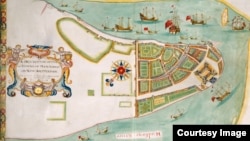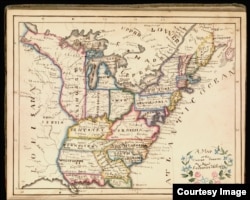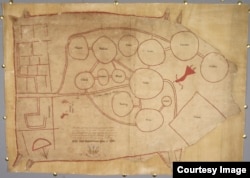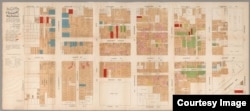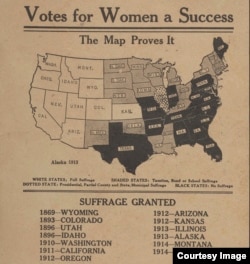Maps do more than show us how to get to where we want to go.
They also can chart a journey into America's past, offering insight into the everyday lives of ordinary people, while highlighting their hopes, dreams and fears dating all the way back to the birth of the nation.
“There is practically no area of American history where maps don’t sort of enrich our understanding and also give us a new angle of vision,” says historian Susan Schulten, author of A History of America in 100 Maps. “Maps record past scenarios, past situations, past relationships of power, but they also influenced people at the time in terms of future decision making.”
Schulten, a University of Denver professor who studies American cartography, was enchanted by a series of maps made by American schoolgirls in the early 1800s. The detailed maps appealed to her not only due to the fact they are beautifully rendered, but also because of what they tell us about a period of American education we know little about.
“New schools educating young women for the first time outside the home prepared a curriculum that involved teaching them not just geography but map drawing," she says. "What they were teaching them was very specific techniques of art and penmanship and understanding geography by creating their own maps.”
The maps these schoolgirls left behind give us a firsthand glimpse into the daily experience of education in the early republic.
Those early maps also helped establish a national identity and nurture nascent patriotism in the earliest days of the republic.
“There’s such an emphasis after the Revolution on using education to help create a civic identity and it becomes readily apparent," Schulten says. "Prior to the American Revolution, your chief loyalty was to your colony and then to the crown in terms of political organization. The Revolution creates a nation and Americans have to be taught to be loyal and to identify with their fellow Americans."
Maps drawn by Native Americans offer insight into indigenous people's perspective of power relationships at a time when Southeast tribes were competing for supremacy in the deerskin trade with the British colonies.
A 1721 map, most likely drawn by a Cherokee leader, includes a number of circles, and their sizes correspond with the perceived power of the individual tribes.
“It’s a representation of space from a non-European perspective," says Schulten. "It isn’t a representation of absolute space, but instead renders geography in terms of power relationships and that’s really fascinating to think about.”
The map also underscores the fact that Native Americans were distinctly different groups of people with competing interests, even though the Europeans viewed them as one monolithic group.
Maps also can recall other dark moments in American history.
An 1885 report on San Francisco's Chinatown highlights the racism endured by Chinese laborers who'd once helped build the transcontinental railroad. After the railroad was complete, many Chinese immigrants settled in San Francisco.
A report commissioned by city supervisors described the Chinese "race" as "the rankest outgrowth of human degradation that can be found upon this continent." A related map of Chinatown points out Chinese-run opium dens, gambling establishments and takes care to distinguish between Chinese and white houses of prostitution.
“There’s a long history of maps as tools of propaganda and persuasion," Schulten says. "Those thriving businesses and communities, as they grew, were understood by whites in San Francisco to be increasingly threatening...The beauty of the maps belies the intent, which is to highlight the argument that the Chinese must go.”
From political maneuvering and gerrymandering, to advertising, to red and blue states, maps tell a variety of American stories. They can also be used to push reform, helping to set the country on a new course.
"Maps are used to convey the importance of temperance in the anti-alcohol movement or the opposition to slavery or the need to extend the vote to women," Schulten says. "All of these reform movements throughout modern America used maps as a way to amplify their message."
Some of the maps in her book have never been published, according to Schulten, while others are well known. But what they all offer, if examined carefully, is a unique snapshot of America's past.




